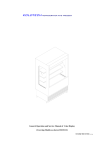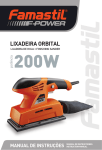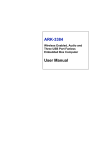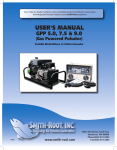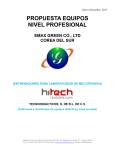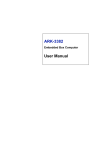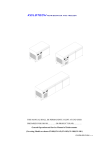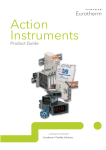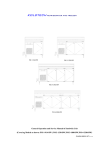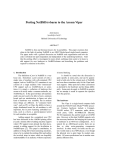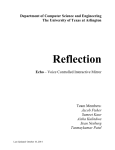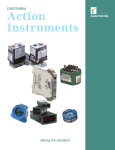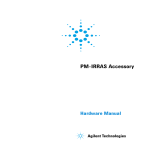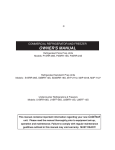Download Entree - Entrée
Transcript
Entrée LLC Refrigeration Products Service Manual Entree Freezer & Refrigerators Installation, Specifications, Service, Electrical Diagrams, Service Troubleshooting Guidelines, Warranty Guidelines Table of Content Section Page Numbers Electrical Requirements-----------------------------------------3 Wire Sizing Chart------------------------------------------------4 Serial Number Information-------------------------------------5 Receiving & Inspection-----------------------------------------6 Equipment Specifications---------------------------------------6 thru 11 Installation of Refrigeration Equipment-----------------------12 thru 13 Equipment Operating Temperatures---------------------------13 Defrost Section--------------------------------------------------14 thru 20 Temperature Controllers----------------------------------------21 thru 25 Sequence of Operation -----------------------------------------25 Compressor Section---------------------------------------------26 thru 31 Refrigeration Section--------------------------------------------32 thru 36 Information About Polyol Ester Oil-----------------------------37 Doors & Hardware-----------------------------------------------38 thru 42 Wiring Diagrams-------------------------------------------------43 thru 66 Warranty Guidelines ---------------------------------------------67 thru 70 Maintenance and Care -------------------------------------------71 thru 73 Lamp Replacement on Merchandiser----------------------------74 2 Electrical Requirements There are several electrical factors that can affect the operation of an Entrée Refrigerator or Freezer. Listed below are items that need to checked prior to installation of your refrigeration equipment? If not checked prior to installation can cause needless service calls and voided warranty. Entrée only uses two types of electrical plugs on their equipment. Your outlets should match NEMA 5-15R Used on units except the 3 Door Freezers NEMA 5-20R Used on All 3 Door Freezers 1-Make sure circuit is a dedicated circuit exclusively for that equipment. 2- No Extension Cords, Use of an extension cord WILL VOID WARRANTY 3-All electrical complies with city electrical codes 4- Check for proper voltage at receptacle prior to plugging in equipment. 5- Voltage drops must not exceed more than 10% on compressor start up. 6-Alteration to electrical plug or cord WILL VOID WARRANTY 3 Wire Sizing Chart To prevent voltage drops in the electrical power being supplied to a given Entrée unit, below is a wire size to amperage chart. To prevent voltage drops of no more than 2% wire size, length of wire run by amperage must match. Volts & Amperage is located on the label location shown page 3 This chart is for only 105 to 120 volts, as all Entrée & Centaur Plus equipment are based on 115 volts. The highest load on any Entrée Equipment would be 20 amps Distance in feet to Center Load 20’ 30’ 40’ 50’ 60’ 70’ 80’ 90’ 100’ 120’ 140’ 160’ Amps Wire Gauge Size 2 14 14 14 14 14 14 14 14 14 14 14 14 3 14 14 14 14 14 14 14 14 14 14 14 12 4 14 14 14 14 14 14 14 14 14 12 12 12 5 14 14 14 14 14 14 14 12 12 12 10 10 6 14 14 14 14 14 14 12 12 12 10 10 10 7 14 14 14 14 14 12 12 12 10 10 10 8 8 14 14 14 14 12 12 12 10 10 10 8 8 9 14 14 14 12 12 12 10 10 10 8 8 8 10 14 14 14 12 12 10 10 10 10 8 8 8 12 14 14 12 12 10 10 10 8 8 8 8 6 14 14 14 12 10 10 10 8 8 8 6 6 6 16 14 12 12 10 10 8 8 8 8 6 6 6 18 14 12 10 10 8 8 8 8 6 6 6 5 20 14 12 10 10 8 8 8 6 6 6 5 5 Warning: Any compressor failing to start due to wire size for length of run, will not be warrantied 4 Serial Number Information: The Model & Serial numbers and other information label are located on the left interior wall at eye level. You will need this information when placing a warranty service call or for warranty parts Serial Numbers: The first 2 numbers are the year the second 2 numbers are the month 1301ENTH00000 = year 2013 Month January For Warranty Service: Entrée Call------------------- 866-417-6140 Centaur Plus Call------------ 866-392-0792 For Tech Support Call------- 570-752-4602 To Purchase Parts Call------ 800-877-2662 5 Receiving & Inspecting The Equipment Even though most equipment is shipped crated, care should be taken during unloading so the equipment is not damaged when being moved. 1: Once you uncrate the equipment, inspect for hidden or concealed damages both inside & out, and also the compressor compartment. 2: If damage is found, notify to freight carrier. If possible take pictures of the damage for your records. And request an inspection by the freight carrier. This should be done immediately. Retain all crating material until inspection has been made. Refrigerants All Entrée & Centaur Plus Refrigerators use R-134A Refrigerant All Entrée & Centaur Plus Freezers use R-404A Refrigerant SPECIFICATIONS For Entrée Reach-In Refrigerators & Freezers Model V/Hz/PH Amps Capacity Cu-Ft’ CR1 CR2 CR3 115/60/1 115/60/1 115/60/1 6 9 10 23 49 72 Model V/Hz/PH Amps Capacity Cu-Ft CF1 CF2 CF3 115/60/1 115/60/1 115/60/1 9 12 17 23 49 72 Capacity Shelf Sq. Ft. 14.0 28.1 42.1 Capacity Shelf Sq.-Ft. 14.0 28.1 42.1 Note: 6 HP BTU Refrigerant Charge 3/8 ½ ¾ 3200 5800 7625 12 R-134A 18.7 R-134A 21.2 R134A HP BTU Refrigerant Charge 5/8 1 2325 3650 4500 15.2 R-404A 1-1/4 26.6 R-404A 28.2 R-404A Shipping weight LBS 350 518 669 Shipping Weight LBS 364 568 776 NEMA Plug Type 5-15P 5-15P 5-15P NEMA Plug Type 5-15P 5-15P 5-20P Specifications Entrée Prep & Under Counter Refrigerator & Freezers Model V/Hz/PH Amps Capacity CU-Ft P47 P70 P94 Model 115/60/1 115/60/1 115/60/1 V/Hz/PH 7.5 7.5 9 Amps 12 22 32 Capacity CU-Ft S29 S48 S61 S29-MT S48-MT S61-MT 115/60/1 115/60/1 115/60/1 115/60/1 115/60/1 115/60/1 5 7 7 5 7 7 7 12 15.5 7 12 15.5 Model V/Hz/PH Amps Capacity CU-Ft UR27 UR48 UR61 WTR27 WTR48 WTR61 115/60/1 115/60/1 115/60/1 115/60/1 115/60/1 115/60/1 5 5 5 5 5 5 6.5 12 15.5 6.5 12 15.5 Model V/Hz/PH Amps Capacity CU-Ft UF27 UF48 UF61 WTF27 WTF48 WTF61 115/60/1 115/60/1 115/60/1 115/60/1 115/60/1 115/60/1 7 9 10 7 9 10 6.5 12 15.5 6.5 12 15.5 Capacity Shelf Sq. Ft. 16 34 54 Capacity Shelf Sq. Ft. 14 26 30 14 26 30 HP BTU Refrigerant Charge ½ ½ ¾ HP 5600 6200 6800 BTU 9.9 R-134A 3/8 ½ 1/2 3/8 ½ ½ 3200 5400 5800 3200 5400 5800 9.5 R-134A Capacity Shelf Sq. Ft. 14 26 30 14 26 30 HP BTU Refrigerant Charge 3/8 3/8 3/8 3/8 3/8 3/8 2800 3000 3200 2800 3000 3200 9.5 R-134A Capacity Shelf Sq. Ft. 14 26 30 14 26 30 HP BTU Refrigerant Charge 1/2 1/2 5/8 1/2 1/2 5/8 3500 3800 4200 3500 3800 4200 12.3 R-4-04A Note: 7 10.6 R-134A 13.8 R-134A Refrigerant Charge 9.5 R-134A 10.6 R-134A 9.5 R-134A 9.5 R-134A 10.6 R-134A 9.5 R-134A 10.6 R-134A 9.5 R-134A 9.5 R-134A 10.6 R-134A 14.5 R-404A 15.2 R-404A 12.3 R-404A 14.5 R-4044A 15.2 R-4044A Shipping Weight LBS 348 432 582 Shipping Weight LBS 276 313 362 276 313 362 NEMA Plug Type 5-15P 5-15P 5-15P NEMA Plug Type 5-15P 5-15P 5-15P 5-15P 5-15P 5-15P Shipping Weight LBS 243 300 348 243 300 348 NEMA Plug Type 5-15P 5-15P 5-15P 5-15P 5-15P 5-15P Shipping Weight LBS 243 300 348 243 300 348 NEMA Plug Type 5-15P 5-15P 5-15P 5-15P 5-15P 5-15P Specifications for Centaur Plus Reach-in Refrigerators & Freezers Top Mount Top Mount Units Meaning: The condensing unit (compressor) is located on top of the cabinet. The benefit to this is the condenser stays cleaner as it is not near floor traffic. 1-The drawback is the air is warmer closer to the top of a room and the customer is not able to stack things on top of the cabinet. 2- Customer should be WARNED when purchasing a Top Mount unit that nothing can be stacked on top of the cabinet. Notes: 8 Specification for Centaur Plus Refrigerators & Freezers – Bottom Mount Bottom Mount Units Meaning: The condensing unit (compressor) is located underneath the cabinet. The benefit to this is the air intake for the condenser is located near the floor where the intake air for the condenser is cooler. The condenser coil is easier accessed for cleaning and service. The drawback to Bottom Mount unit is the air intake to the condenser is more susceptible to dirty & lint being drawn on to the condenser surface. WARNING: All Condenser should be check and cleaned every 30 Days Note: 9 Specifications for Centaur Plus Prep & Under Counter Refrigerators & Freezers Notes: 10 Specifications for Centaur Plus Glass Door Refrigerators & Freezers Swing Door Refrigerators Model V/Hz/PH AMPS Capacity CU.-FT. HP BTU Refrigerant & Charge OZ Shipping Weight CGD-1DR-12 CGD-1DR-16 CGD-1DR-23 CGD-2DR-48 CGD-3DR-70 115/60/1 115/60/1 115/60/1 115/60/1 115/60/1 6 6 6 7 10 12 16 23 48 72 3/8 3/8 3/8 ½ ¾ 2800 3000 3200 5800 7625 12 R-134A 12 R-134A 12 R-134A 18.7 R-134A 21.2 R-134A 254 282 331 540 741 NEMA Plug Type 5-15P 5-15P 5-15P 5-15P 5-15P Swing Door Freezers Model V/Hz/PH AMPS Capacity CU.-FT. HP BTU Refrigerant & Charge OZ Shipping Weight CSD-1DF-12 CGD-1DF-16 CGD-1DF-23 CGD-2DF-48 CGD-3DF-70 115/60/1 115/60/1 115/60/1 115/60/1 115/60/1 11 11 11 12 16 12 16 23 48 72 3/8 5/8 5/8 1 1¼ 2325 2800 3000 3650 4500 10.6 R-404A 11.3 R-404A 14.1 R-404A 25.0 R-404A 28.9 R-404A 258 289 353 567 829 NEMA Plug Type 5-15P 5-15P 5-15P 5-15P 5-20P Model V/Hz/PH AMPS Capacity CU.-FT. HP BTU Refrigerant & Charge OZ CGD-2DR-47 115/60/1 7 47 ½ 5800 18.7 R-134A Shipping Weight LBS 540 NEMA Plug Type 5-15P Notes: 11 Installation of all Refrigeration Products Location: Units represented in this manual are intended for indoor use only. Be sure the location chosen has a floor strong enough to support the loaded weight of the cabinet and its contents. A fully loaded cabinet can weight can be as high as 1500 pounds. Reinforce floor as necessary to provide for maximum weight. For the most efficient operation of the refrigeration system be sure to provide good air circulation inside and out. Check specification sheet for unloaded weights Inside The Cabinet: Do not pack the cabinet in such a way to prevent good air circulation. This is important to provide good heat recovery from all the product and prevent freeze ups or damage to the compressor. This will also cause overflow of evaporator drain pans and loss of temperature. The shelves are wire type to allow good air circulation through the product. DO NOT cover shelves with any type of covering such as aluminum foil. Boxes or packages should be placed in such a way to allow air flow through them. DO NOT stack package or boxes against the interior back wall, as this will stop air flow or against the intake air inlet to the evaporator coil. Outside The Cabinet: Cabinet should have access to ample fresh air. ALL Cabinets should be at least 2 inches off any interior wall to prevent re-circulation of hot air into the condenser coil. If the unit is not provided with proper air circulation to the condenser coil, an increase in temperature will occur. This could also cause damage to the compressor and refrigeration system. Leveling: A level cabinet looks better and will perform better because the doors will be aligned properly. Improperly leveled cabinet can cause condensate water to overflow either the evaporator or condensate drain pans. Use a level to properly level you refrigeration unit, to ensure proper operation of the cabinet. 12 Stabilizing: All models are supplied with casters for your convenience, ease of cleaning underneath and for mobility. It is very important, however, that the cabinet be installed in a stable condition with the front wheels locked while in use. Should it become necessary to lay the unit on its side or back for any reason, allow at least 24 hours before start-up so as to allow compressor oil to flow back to the sump. Failure to meet these requirements can cause compressor failure and unit damage. Laying a cabinet on its side or back can also cause the motor mounting springs inside the compressor to come off. This will cause the compressor to make a banging sound at start up or shut down. Warning: Unit repairs will not be subject to standard unit warranties due to improper installation procedures. Warning: The unit should always be disconnected or unplugged when performing any kind of service or maintenance. Operating Temperatures: Refrigerators All Entrée products refrigerators have a set point setting of 34 degrees F, At 34 degree the compressor will cycle off. The refrigerator has a differential setting of 4 degrees F. The refrigerator will cycle the compressor back on when the temperature rises to 38 degrees. This should maintain a product temperature of approximately 35 degrees continually. Freezers All Entrée products freezers have a set point setting of -7 degrees F. At -7 degrees the compressor will cycle off. The freezer has a differential setting of 4 degrees F. The freezer cycle the compressor back on when the temperature rises to -3 degrees. This should a product temperature of approximately -5 degrees continually. 13 Defrost Section Refrigerator Defrost Frequency: 6 hours from the time power is first applied to the cabinet the first defrost will occur and every 6 hours of continual use. If power is interrupted by a short power outage this will cause the unit to restart its count and the unit will go into defrost 6 hours after power is restored. This could cause the unit to miss a defrost cycle, and could cause a freeze up of the defrost coil. You can place the unit into a manual defrost by pressing the snow flake to the left of the “set” button on the controller and hold down for 4 seconds. Defrost Duration: Maximum of 20 minutes factory setting or when the evaporator probe reaches a temperature of 41 degrees F. or whichever comes first. Freezer Defrost Frequency: Defrost Frequency: 6 hours from the time power is first applied to the cabinet the first defrost will occur and every 6 hours of continual use. If power is interrupted by a short power outage this will cause the unit to restart its count and the unit will go into defrost 6 hours after power is restored. This could cause the unit to miss a defrost cycle, and could cause a freeze up of the defrost coil. You can place the unit into a manual defrost by pressing the snow flake to the left of the “set” button on the controller and hold down for 4 seconds. Defrost Duration: Maximum of 20 minutes factory setting or when the evaporator probe reaches a temperature of 45 degrees F. or whichever comes first. Defrost is controlled by the controller and can be changed by going into the parameters. This is not recommended, but can be change to fit the volume of the use of the refrigerator or freezer. The number of times the door is opened is the volume of the use. NOTE: More about defrost is cover in the Controller Section 14 Drain Tube Heater Note: All Entrée & Centaur Plus have drain tube heaters that operates only during the defrost cycle. The drain tube heater part number H00211 is used on all freezers, and it is 115v at 13 watts and approximately .007 Amps Defrost Heater Amperage per Model Note: None of the refrigerator models in either Entrée or Centaur Plus have defrosts heaters. All refrigerators are off cycle defrost, the compressor is turned off a maximum of 20 minutes. All Entrée & Centaur Plus Freezers have electric defrost heaters, listed below is the amperage for each model. Entrée Reach-ins Model CF1 CF2 CF3 Volts and Watts 115 V at 550 watts 115 V at 800 watts 115 V at 1100 watts Total Defrost Amps 4.85 7.03 9.63 Part number H00201 H00202 H00203 Total Defrost Amps 2.98 4.09 4.10 Part Number H01201 H01202 H02201 Total Defrost Amps 4.85 7.03 9.63 Part Number H00201 H00202 H00203 Entrée Under Counters & Worktops Model UF27 & WTF27 UF48 & WTF48 UF61 & WTF61 Volts and Watts 115 V at 335 watts 115 V at 463 watts 115 V at 464 watts Centaur Plus Bottom Mount Freezers Model CSD-1DF-BAL CSD-2DF-BAL CSD-3DF-BAL Volts and Watts 115 V at 550 watts 115 V at 800 watts 115 V at 110 watts 15 Centaur Plus Top Mount Freezers Model CSD-1DF-TSI CSD-2DF-TSI CSD-3DF-TSI Volts and Watts 115 V at 550 watts 115 V at 800 watts 115 V at 110 watts Total Defrost Amps 4.85 7.03 9.63 Part Number H00201 H00202 H00203 Total Defrost Amps 2.98 4.09 4.10 Part Number H01201 H01202 H02201 Centaur Plus Undercounter & Worktop Model CUF27 & CWF27 CUF48 & CWF48 CUF61 & CWF61 Volts and Watts 115 V at 335 watts 115 V at 463 watts 115 V at 464 watts Troubleshooting Defrost Related Problems: How to Initiate a Manual Defrost: Push the snowflake to the left of the set button and hold down for 4 seconds to activate a defrost cycle. Note: A freezer temperature must be below 20 degrees F. for it activate a defrost cycle. A refrigerator must be below 38 degrees F. to activate a defrost cycle. After 4 seconds the compressor and interior fan motors should shut off and the LED light under the snowflake with droplets should light up. 16 Once unit is in defrost: Step 1- If the unit is a 2 door or 3 door reach-in there will be a defrost contactor located behind the shroud the controller is mounted on. To open shroud, remove screws above the doors, the top of the shroud is hinged so the shroud can be swung up to give you easy access to wiring & components. Step 2- Identify the defrost contactor; it will be the contactor that is energized. If neither contactor is energized, then go to the # 7 terminal on the controller, with a volt meter check voltage to a neutral (white) wire. A- No voltage, controller is bad replace it. B- If you have voltage at #7, then check voltage at the defrost contactor coil, if you have voltage to the coil, but the contactor is not energized the contactor coil is open, replace the contactor. C- If the contactor is energized check the terminals across the contactor, no voltage reading the contactor is closed. If you get a voltage reading the contactor terminals are open, replace the contactor. D- If you determine the contactor is good, place an Amp Meter cross the terminal or load side terminal. If you get an amp reading check one of the charts to match the model number in defrost amp section of this book to determine if it correct. E- No amp reading, then either you have an open defrost heater, an open thermal cutoff or a loose connector. F- Pictured below is the Thermal Cutoff, it should be bypassed to determined that the defrost & drain tube heaters are both okay G- If defrost heater and drain tube heater test okay, replace thermal cutoff 17 Defrost continued; Note: The same procedure above will apply as a troubleshooting guide for the single door reach-in and the Undercounter & Worktop Freezer. There is no defrost contactor on the single door reach-in or the undercounter or worktop units. Defrost circuit to defrost heaters comes directly off the #7 terminal of the controller. Defrost Heater: Is located underneath the evaporator coil. Step 3- Changing Defrost Settings Note: Changing the defrost setting will not always cure the evaporator freeze up problem. Be sure steps 1 & 2 have been accomplished prior to making any changes in the defrost settings. They should only be changed when the unit is in a high volume kitchen or high humidity area. If it is determined a change must be done to the settings: A- The controller controls all defrost settings. 18 Defrost Continued: B- To get into the parameters see instructions on the picture above. Once “HY” appears release both the down arrow & set buttons, then push and release” set” only to go through the parameters. C-The Defrost Parameters: Parameter code Description dtE idF MdF Defrost Termination Temp Intervals between Defrost Minutes of the Defrost Default Setting 45 6 20 Maximum Setting 52 4 30 Causes of Evaporator Freeze Ups for Freezer: 1- Thermal Cutoff open – Defrost Heaters will not operate in the defrost cycle if the thermal cutoff is open. 2- Defrost Heater Open- Have voltage at the defrost heater wires, but no amp draw. Determine with an Ohm meter if heater has an open circuit. 3- Failed Defrost Contactor- Either open coil or contacts 4- Failed Controller- open contactor at terminal #7 on controller 5-Failed Drain Tube Heater- This will cause the drain to freeze up stopping the flow of condensate water during defrost cycle. 6-Clogged Drain- Trash or left over particles from manufacturing can clog drain 7-Poor air circulation inside the cabinet. 8- Door left ajar 9- Failed Evaporator Fan Motors- No air moving across the evaporator coil to gain heat. 10- Bad door switch (only on the Centaur Plus Units) this will keep the evaporator fan motors from operating. 11- Loose or burnt wire connectors12- Dirty evaporator coil- No air movement through the evaporator coil. 19 Defrost continued; 13-Evaporator Fan Blade loose or on backward 14- Bad Door Gaskets Causes of Evaporator Freeze Ups for Refrigerators: Note: Refrigerators do not use defrost heaters or contactors; they are strictly turn off the compressor for up to 20 minutes. 1- Low Refrigerant Charge- If the unit cannot reach set point setting of 34 degrees F. The P2 evaporator sensor will not allow the unit to go into a defrost cycle. The will never reach the 34 degree set point. The unit runs continually until it freezes up. 2- Dirty condenser or poor air circulation around the condenser. The results will be as described as in step 1. 3- Clogged drain 4-Failed controller: Will not go into manual defrost even with the temperature at 34 degrees. 5- Bad evaporator fan motor 6-Evaporator fan blade is loose or on backward. 7- On Sandwich / Salad or Pizza Prep units the condiment pans have to be in place on the rails to keep warm air from entering the unit. If they are left out overnight or long periods of time or don’t fit properly on the rails, this can also cause an evaporator freeze up. Make sure all pans set completely down on the rail to make a good seal. 8- Bad Door Gaskets 9- The Controller’s set point is set to cold. Set point on refrigerators should never be set below 33 degree F. Notes: 20 Controllers Note: Listed below are the specifications for the Dixell Controllers. Entrée only uses the Dixell XR20C for Refrigerator units and the XR60C for the Freezer units. Sometimes you may receive a Dixel XR02CX as a replacement for the refrigerators. The parameters will be the same as the XR20C. Set Point – Is the temperature the compressor will cycle off Differential – Added to the Set Point is the temperature the compressor will cycle back on. Example: Refrigerator factory Set Point 34 degree F. plus 4 degree differential = 38 degree F ALL REPLACEMENT CONTROLLERS ARE PRE-PROGRAMMED AND A “HOT KEY” IS NOT NECESSARY. Trouble Shooting Tips for Controller: 1- Do you have a temperature reading on the controller. If no then you have no power to the controller. Check the power switch, power cord and breaker. 2- Controller has a temperature reading, but nothing is running. Are any of the LEDS lite up. 21 a- Check set point setting, Freezers should be at -7 degrees and refrigerators at 34 degrees. b- If set points are correct, check output voltage to fans & compressor. No output voltage, replace controller. Alarm Display: P1 is flashing on the controller. This is an indication of failure in the thermostat probe located near the intake air of the evaporator. To resolve this failure: 1- Inspect for a loose connection at the controller on terminal 11 or 12. 2- Inspect that it is wired properly as this happens often when replacing the controller. 3- Inspect for cut or nicks in the probe wire. 4- If all the above check okay, replace probe P2- is flashing on the controller. This is an indication of failure in the evaporator probe located on the front side of the evaporator coil. To resolve this failure: 1- Inspect for a loose connection at the controller on terminal 10 or 11. 2- Inspect that it is wired properly as this happens often when replacing the controller. 3- Inspect for cuts or nicks in the probe wire. 4- If all the above checks okay, replace probe Both P1 & P2 are flashing on the controller. This will occur, but rarely. 1- Inspect all wire connections of 9, 10, 11& 12 terminals. Note: The “11” terminal is the common terminal for all probes. 2- Best advise if you are getting an indication of failure on all probes Replace the controller and probes 22 P3- is flashing on the controller. This is an indication of failure in the condenser probe located on the compressor discharge line at the condenser coil. Use the same steps as for P1-P2 probes, except the terminals will be 9 & 11. Note: The P3 probe is not used on all units, only those with only one condenser fan motor. CSd- is flashing on the controller. This is an indication of high compressor discharge temperatures. 1- The condenser coil is clogged with trash or dirt. Clean 2- The condenser fan motor has failed. Replace 3- Bad air circulation, inspect the location of the unit and determine if it is getting the proper air flow to the condenser coil. All cabinet should be at least 2” off any interior wall. Units are not designed to operate in ambient temperature above 95 degrees F. Controller Alarms continued: HA – is flashing on the controller. This is an indication the unit has reached the high temperature alarm setting, and has remained there for more than 90 minutes. This could be caused by several conditions. Inspect the unit this may require putting refrigeration gauges on the system. LA- is flashing on the controller. This is an indication the unit has reached the low temperature alarm setting, and remained there for more than 90 minutes. This could be cause by several conditions, such as a bad controller or stuck contactor. Warning: Prior to changing any parameters on the controller, you need to check with Entrée Technical Support, by changing any setting can change the set up of the engineering design. 23 Controller Terminals: Refrigerator Controller Terminals Freezer Controller Terminals Location of Contactors and Terminal Boards Located behind upper shroud Notes: 24 Dixell Specification: 25 Compressor Troubleshooting Section Quick Check Reference: A) Compressor not operating: 1) Is the compressor extremely hot? a) If the compressor is not operating and the condenser fans are operating, Compressor is extreme hot, the compressor is off on the overload. b) Is the condenser coil clean? You should be able to see light through the condenser coil. c) Compressor tries to start but trips overload. 1) What is the amp draw at the common terminal? 2) What is the startup voltage at the common & run compressor terminals. 3) Have you checked for burnt wire connection? 4) Have you tried a hard start kit, Start Cord or Compressor analyzer? B) Compressor is cool to touch & not operating, condenser fan is operating 1) Have you checked voltage at the compressor terminals? 2) Have you taken Ohm readings across the terminals? 3) Checked for burnt or loose connections? C) Neither compressor or condenser fan motor operated. Compressor is cool to touch. 1) Checked voltage at the compressor contactor coil? Continued on the next page 26 Compressor Trouble shooting continued Contactor & Terminal locate behind shroud in right hand picture Compressor Contactor Upper shroud is hinged a) Is the controller giving a digital reading? Is the snow flake lite up at the top of the temperature readings? b) If no power go to back of the controller and check power on the compressor terminal. Terminal # 5 for refrigerators and terminal #3 for freezers c) Checked voltage at the terminal board terminals that feed power to the condensing unit. Compressor Troubleshooting continued: d) Loose wire or connector D) Compressor Operating, but no cooling a) Is the condenser clean? b) Is the compressor discharge line hot or cool? c) Is the there any heat on condenser coil? d) Is the drier or cap tube sweating? e) Is the evaporator coil iced up? 27 Embraco Aspera Compressors for Entrée & Centaur Plus Typical Compressor wiring diagrams For the models of Embraco/Aspera compressor used for Entrée / Centaur Plus 28 Compressors continued: The Potential Start Relay: The potential (voltage sensing) start relay places the starting capacitor in series with the start windings. It does so by sensing voltage across the start winding, rather than line current as does the current relay. The contacts of the potential relay are normally closed and the start capacitor is connected to the start winding as soon as power is applied to the compressor motor. The relay’s coil senses the voltage dropped across the start winding. It is designed to pick up, open its contacts, and disconnect the start capacitor from the start winding, WHEN SUFFICIENT VOLTAGE IS GENERATED. Since the voltage or back-EMF generated by the start winding is proportional to the motor speed, the relay will open only when the motor has started and is approaching normal running speed. EMF= Electromotive Force This is why it is very important to have units with larger compressor such as 3 door freezers being supplied with sufficient voltage and no voltage drops at the compressor terminals. Any voltage drop at the compressor of more than 10% will cause continual circuit breaker trips. The Current Relay Current Starting Relays are used on the smaller compressor motors. The current relay contacts are normal open when de-energized, unlike the potential relay with closed contacts. Current relay its coil is wound with heavy wire and is placed in series with the incoming power line. The connections to the current relay are L, M, and S alternate connections are 1, 5, and 2. When the compressor is energized in –rush currents pass through the current relay coil, its contacts close and connect the start winding to the motor circuit. The start winding is wound with a higher resistance than the run winding, this changes its phase current with respect to the run windings, and produces the torque requires for the motor to start. The relays contacts open when current drops as the compressor comes up to speed, and the start windings is disconnected from the motor circuit. A current or potential relays can be tested with an Ohm meter for open or closed contacts or open coils. 29 Compressors continued Most Common Compressor Failures: Locked Up or Seized Motors: What is the Locked Rotor Amps (LRA), check nameplate LRA to see if they match. This can only be tested with an Amp meter on the Common or Run terminals. Cause is normally by loss of good lubricating oils, liquid refrigerant flood back or high discharge temperatures. Refrigerant oils, high discharge temperatures and flood back are covered in the refrigeration section. Open Windings: This can only be tested with a good Ohm meter. Causes of open windings are normally caused by spot burns in either the start or run windings and the breakdown of the motor insulation. Shorts to Ground: Can be tested with a good Ohm meter, by checking each terminal to the compressor case or copper lines attached to the compressor. Listed below is the most common cause of open windings or burnt compressors 1- Mis-wired 2- Solid contaminants in the refrigeration system 3- High acid in the refrigeration, due to previously poor clean ups of the refrigeration system. 4-Operating out of specification 5- Loss of lubrication 6- Flood backs causing liquid refrigerant to be in crankcase 7-High discharge temperatures and inadequate sub-cooling for the compressor motor 8-Short cycling 9- Failed starting components 30 Compressors continued; Inefficient or Non pumping Compressor : Can only be determine with the installation of refrigerant gauges on both the high side and low side of the system. This cannot be determined by Amperage. Determining if a compressor is inefficient, normally with both gauges on the system, the system is operating at low head pressure, high suction and low amperage. Sometimes when the compressor is turned off the suction line will get hot quickly. Most common cause: 1- Poor maintenance: Condenser coil is dirty or clogged, condensers coils should be cleaned at every 60 days. 2- Liquid Refrigerant Flood Back: Evaporator freezes ups is one of the most common cause of liquid flood back, due to no heat gain to boil off refrigerant. Over charging with refrigerant is a very common failure with a capillary system, all refrigerant charges should be weighted in to the factory name plate spec. Refrigerator or freezer doors are open for long periods, keeping the evaporator fan motors from operating. Internal Noise: Compressors are not designed to be laid on their side or turned upside down. A hermetic compressor has internal mounting springs, which can come off the mountings when this occurs. When this occurs the compressor will make a banging sound at start up or shut down. Liquid refrigerant is the other thing that can cause a compressor to be noisy. A well trained refrigeration technician should take time to investigate the cause of compressor failures. Often this is not done, causing repeated callbacks they expect the customer or manufacture to pay. Make it right the first time. Notes: 31 Refrigeration Section All of the Entrée & Centaur Plus Refrigeration Systems are capillary type systems, as in the refrigeration diagram below. THE CAPILLARY TUBE REFRIGERATION SYSTEM Basics how a capillary system operates: Starting at the motor compressor the refrigerant from a low pressure gas is compressed to a high pressure gas and pumped into the condenser. In the condenser with the condenser fan motor circulating air over the refrigerant inside the condenser coil, the refrigerant is condensed from a high pressure gas to a high pressure liquid. The high pressure liquid then leaves the condenser and enters the drier, which is designed to remove moisture & contaminants that maybe in the system. Liquid refrigerant enters the capillary tube, the pressure is reduced as it enters the evaporator coil, the liquid refrigerant starts to boil as heat is picked up in the evaporator and the refrigerant changes to a low pressure gas. The low pressure gas enters the accumulator to boil off any liquid refrigerant prior to returning to the compressor through the suction line. 32 Refrigeration continued: The Capillary Tube: The capillary tube is probably the simplest of all metering devises. The capillary tube is commonly used as a metering devise used on self-contained refrigerators and freezers. It is constructed of a single tube with inside diameter in the range of .026 to .090 inches. It is between the drier & the evaporator coil, and a large portion of it maybe coiled either at the evaporator or in the condensing unit section. See picture to the below, most generally the capillary tube is either soldered or foil taped to the suction line to create a heat exchanger. The size of the cap tube and the length are carefully selected to match the pumping capacity of the compressor, saturation of the evaporator and sub-cooling to the compressor motor Advantages of a capillary tube system are no mechanical parts to fail and the pressure equalize quickly after the compressor shut down. Disadvantages of a capillary system are they can become plugged due the size of the inside diameter. The evaporator can be filled with liquid when the compressor is shut down. Some manufactures install liquid line solenoids in the liquid line to prevent this from occurring. With today’s refrigerants & polyester oils being used with capillary tubes it is very important not to operate a system with high discharge temperatures above 250 degrees, as POE oil start to become gummy at approximately 275 degrees. This will cause the drier to get plugged and a breakdown of the desiccant beads. If you inspect a restricted capillary lined with WHITE POWDER inside, this has occurred. 33 Refrigeration continued: Causes of High Discharge Temperature: High discharge temperature is when the temperature at the discharge valve inside the reach temperature high enough to do damage to the system. 1- Dirty or clogged condenser coil is the most common, poor maintenance by the owner of the equipment. 2- System operating with no or low refrigerant charge, this will cause the overheating of the compressor motor by no sub-cooling at the compressor. 3-Restricted capillary tube or kinked suction line will cause the same results as previous note in low refrigerant. Testing: Remember a refrigeration system has 2 sides. When testing for restriction or low refrigerant charge, always install both the refrigerant high side & low side gauges. You can add 4 ounces of refrigerant to the system to check if both pressures increase. If the unit has some refrigerant in the system, cover up the front of the condenser coil, as the high side pressure starts to increase the low side pressure should also start to increase, if the unit is low of charge. If the unit is restricted, you’ll not see an increase in pressure from the low side, and only a slight increase on the high side. A sweating drier or capillary tube is good indication of a restriction. Testing for Leaks: Once you have determined the unit is low of refrigerant. The unit definitely has a refrigrant leak, systems are not shipped out low of refrigerant. You can add a blend of nitrogen & refrigerant to the system, and increase the pressure up to 175 PSI. Pressure above 175 can do damage to the system. Using a (sniffer type) leak detector go over the system thoroughly. None of the Entrée products line sets are inside the foamed walls and all are accessible. But remember the foam will set off a leak detector. Once a leak is located and repaired (if repairable) replace the drier, vacuum to 200 microns, test to see if vacuum holds, recharge the system to the factory specs. The drier capacity is equal to 032 drier. 34 Refrigeration continued Warning: Do not install only low side gauges and start adding refrigerant to the system, as this can do damage to the compressor. And never add liquid refrigerant to the low side, this will damage the low side reed valves in the compressor. Always use good refrigeration practices. 4- Oil Logged Evaporators: This is something that rarely happens on small systems. If you do encounter this failure, place the system into a prolonged defrost, or heat the evaporator up with a hot air gun. This will warm the refrigerant oil to increase the viscosity of the oil and allow it to return once the compressor starts up. If this fails to remedy the problem, then the evaporator and accumulator will have to be removed and drained of the oil and then purged with nitrogen. Remember to fill a cup with the drained oil and add that amount back into the compressor. Good Refrigeration Practices: Being a good refrigeration technician is being a good investigator. We in technical support may ask you many questions. We are not questioning your abilities as tech, but investigating to find a remedy to the problem. We in tech support are only as good as the technician on the end of the phone line. A good technician will find the cause of the problem, and remedy the problem to eliminate it from happening again. Before going into any refrigeration system, remember that POE oil is very hydroscopic and absorbs moisture. Never leave a system open to the atmosphere for more than 15 minutes. Always make sure you have every tool, etc. required to do the job prior to opening a system. Prior to going into a system a technician can tell a lot by feel. Feeling of the side of the condenser can tell if any heat is present and starting at the top and running your hand top to bottom will tell you if you are condensing refrigerant or moving refrigerant. Feeling of the suction line at the compressor will tell the tech if there is sub-cooling at the compressor or if ice is present. If ice is present at the suction line at the compressor, you are not gaining heat from the evaporator coil. Look at your drier and capillary tube in the condensing section, is there sweating present. These are simple test prior to tapping into a system. Tapping into a system is the last thing a tech should do. Entrée will not kill a warranty if you tap into a system after all these things have been tested. 35 Refrigeration continued If you tap into a system, always tap into both the high & low sides. There are ¼” processing tubes on both sides. Never call tech support to ask for refrigeration help without having both readings, as we cannot help. We’ll only ask you to go back to get both. Once you have tapped into the refrigeration system. For testing purposes refer back to testing earlier in this refrigeration section. Replacing Refrigeration Components: Never heat up or unsolder a drier when removing it from the system, this releases contaminates into the system. Cut it out with tubing cutters. Inspect the drier for gummy oil buildup or broken down desiccant beads. Prior to installing a new refrigeration component into a system, it is our recommendation the system is flushed, either by nitrogen a designated flush. If the system has a burn out on the compressor windings, an acid test is good means to test the refrigerant oil. Acid in the system is a compressor failure waiting to happen. You can acquire an acid test kit from any local refrigeration supply. A clean refrigeration system is system that will work properly with no return calls. Notes: 36 Polyol Ester Oil: After 20 years of using this lubricant in the refrigeration system, it has not improved. HFC refrigerants require the use of POE oil for all Entrée compressors. This is necessary for two specific reasons. First, mineral oils are not readily miscible in HFCs. When using HFCs mineral oils will not return to the compressor. Secondly, the chlorine contained in CFCs and HCFCs aids in the lubricity of the mineral oil. POE oil has its drawbacks, first it is hydroscopic, moisture rapidly builds in this oil when left to the atmosphere. Fifteen minutes is the longest any system should be left open. Once moisture is mixed with the POE oil it is impossible to remove. Drain the compressor crankcase, flush the system and install a new drier. Even this may not be enough. Second, POE oil breaks down at high discharge temperatures, causing it to become gummy. This will cause restrictions in the drier and metering devise. Once this occurs it is almost impossible to remove. Again drain the compressor crankcase by pouring it into a measuring cup, add fresh oil to the crankcase. Flush the system with a good flush that is purchased from your local refrigeration supply. Replace the drier. Cleaning up a system is very important when using POE oils. It is not as forgiving as mineral oils. Notes: 37 Doors & Hardware Casters: There are only two size of casters used on Entrée refrigeration products. All casters are of the platform type. Below is the bolt holes pattern, at 2 3/8” centers. a- The H01316 is used on all the salad/sandwich and under counter units. This is a 2.5 inch wheel, which will increase the cabinet height approximately 3.5 inches b- The H00316 is used on all reach-in and pizza prep units. This is a 4” wheel, which will increase the cabinet height approximately 5.5 inches. Entrée does not at this time provide caster shims to level the cabinet. Legs are not available for any of the Entrée or Centaur Plus units at this time. Notes: 38 Door Gasket Replacement There should be no tools required to replace a door gasket on any of the Entrée or Centaur Plus Refrigeration units. The door gaskets backside has a dart with a barbed end. The dart inserts into a plastic groove on the inside of the door. The barbed end holds the gasket in place. To remove the old gasket is very simple as show in the picture below. Garb the old gasket and pullout until enough of the gasket is out to place your hand under it, you can pull out the reminder of the old gasket. Installing the new gasket by start in the upper corner and pressing the dart into the groove on the inside of the door, then across the top, down each side and across the bottom. Note: Some gaskets have been rolled up for storage in the parts bins. They maybe twisted and difficult to work with. These storage memories in the rubber gasket can be taken out by place the gaskets in hot water for a few minute. Once the new gasket has been installed, check to make sure it is sealing good against the cabinet. If an area is not sealing good, warm that area up with a hair dryer and light pull out on the gasket at the same time, this will allow the magnet then to seal against the cabinet. Once the gasket has been installed a few days, re-check that no frost or sweating is on the inside of the door or face of the cabinet. No frost or sweating means you have a good seal. 39 Doors and Hardware continued: Pictured (picture 1) below on the left is part of the hinge assemblies mounted to the door. Both inserted into a square openings in the top and bottom of the door. The longer of the two is called the hinge cartridge. The hinge cartridge has the spring inside which makes the door self-closing. When replacing this component always preload the spring by place a wrench on the square stub and turning it the direction the door closes until resistance from the spring is met. This will ensure the door to work properly after it is back on the cabinet. The other part is the carrier for the Axis Hinge Pin. It is mounted to either the top or bottom of the door depending on the application. Pictured ( picture 2) below on the right is a picture of the Axis Hinge Pin bracket new style, which is used on most all of the Entrée and Centaur Plus units. Picture 1 Picture 2 Note: Door replacement parts are available for all Entrée, Centaur Plus and Centaur Plus Glass Door Merchandisers. 40 Doors and Hardware continued: Pictured (picture 3) below is the old style Axis Hinge Pin, this was used on Entrée units only prior to 2010. These can still be ordered under part number H00327A. The new style are pictured in picture number 2 on the previous page. Picture 3 When replacing these old style Axis hinge pins, always use liquid lock tight on the threads to keep the nut from backing off. Note: You cannot replace the old style hinge pin (H00327A) with the new style H00327). Centaur Plus Doors There is no replacement handle available at this time, the entire door must be replaced. 41 Glass Door Replacement & Adjustments Centaur Plus Glass Doors, there no replacement glass insert available door will need to be replaced. Swing Door Replacement and Adjustment 1. Open the bottom shroud and support the door weight. Loosen bottom hinge’s screws and remove the door 2. Prepare new door. Insert door top pin into top hinge. Insert the bottom hinge onto the door’s bottom hinge and secure to the frame 3. Allow the door to freely swing, make sure it swings close by itself with no restriction 4. Plug the unit in and make sure the lock is in the right location. Exercise the lock to ensure the cam engagement 5. If not, adjust the door until proper lock cam engagement Slide Door Replacement and Adjustment 1. Remove the hook of counterweight on the top of the door 2. Lift the door up until its bottom edge over the channel. Slide it out and down away from the cabinet. 3. Reverse the procedures to install new door Remove the shroud 1. Open the door/s. 2. Loosen and remove the top screws 3. Slide the shroud up and out of their keyhole shape slots Light Bulb Replacement 1. Top display light bulb replacement: Loose the screws in the bottom of top shroud, swing the top shroud up until it is hold by the top of the cabinet, now light bulb can be replaced; 2. Interior light bulb replacement: Open door and remove the cover. Twist and remove the bulb. 42 Wiring Diagrams Reach-in Refrigerator; CR1, CR2, CR3 43 Freezers Wiring Diagrams; CF1, CF2, CF3 44 Salad/Sandwich, Pizza Prep, Undercounters, Worktop 45 Undercounter, Worktop Freezers 46 Wiring Diagrams Centaur Plus Bottom Mount One Door Refrigerators 47 Bottom Mount Two Door Refrigerator 48 Bottom Mount Three Door Refrigerator 49 Bottom Mount One Door Freezer 50 Bottom Mount Two Door Freezer 51 Bottom Mount Three Door Freezer 52 Top Mount One Door Refrigerator 53 Top Mount Two Door Refrigerator 54 Top Mount Three Door Refrigerator 55 Top Mount One Door Freezer 56 Top Mount Two Freezer 57 Top Mount Three Door Freezer 58 Salad/Sandwich, Undercounters, Pizza Prep & Worktop Refrigerators 59 Undercounter & Worktop Freezers 60 Glass Door Merchandisers Single Door Refrigerator MODEL: CGD-1DR-12/CGD-1DR-16/CGD-1DR-23 61 Glass Door Merchandiser Two Door Refrigerator MODEL: CGD-2DR-48/CGD-2DR-47 62 Glass Door Merchandiser Three Door MODEL: CGD-3DR-70 63 Glass Door Merchandisers Freezers MODEL: CGD-1DF-12/CGD-1DF-16/CGD-1DF-23 64 Glass Door Merchandiser Two Door Freezer MODEL: CGD-2DF-48 65 Glass Door Merchandiser Three Door Freezer MODEL: CGD-3DF-70 66 Warranty Section Warranty Allowances for all Entrée Refrigeration Products Including Entrée, Centaur Plus®, CCK, Better Build. All warranty claim invoices must include the following information for the invoice to be processed. If this information is not included on the invoice, it will be denied and returned with a letter of explanation. A. B. C. D. E. F. G. H. Serial Number Model Number End User (Customer) business name, location and phone number. Invoice must be signed by the customer or a person in their employment. The National Service Coop Service Request number. All invoices that are determined not to be a manufacturing defect will be denied. All invoices that are not readable will be returned with a denial letter. All invoices out of the guidelines of these allowances will be adjusted to the allowance, unless prior approval and accompanied by authorized number from the Entrée Technical Service Department. Entrée does not pay for Helper charges or Trainee charges. All work can be performed by one technician. Any Helper charges will have to be prior approved by Entrée Technical Service Department. Entrée Technical Support 1-704-464-3008 ext. 2 End Users (Customers) Responsibilities: A. To verify through NSC the unit is under warranty. A Bill of Sale may be required. B. Pay for normal maintenance and adjustment. Entrée does not pay for adjustments, unless prior approved. C. To reimburse the service company for all non-warranty issues at the rates, travel time, etc. set by the service company. Failure to do so could result in a void warranty. D. Entree does not pay overtime or holiday charges, additional travel charges not covered by warranty, equipment or tool charges not covered by warranty allowances. Entrée is not responsible for the loss of any product or economic loss as a result of failure of this product, caused by either, poor maintenance, acts of nature or defects. 67 Payment for Warranty Travel: A $100.00 charge for the first trip and $85.00 for the second trip with approval. A $120.00 charge for the first trip and $100.00 for the second trip with approval for the following high traffic areas within the metro areas. Atlanta, Boston, Chicago, Dallas-Ft. Worth, Ft. Lauderdale, Houston, Los Angeles, Miami, New York City, Philadelphia, San Diego, San Francisco or any area that would be considered a metro area. Warranty Parts Orders & Shipping Charges: All warranty parts sent out by Entrée parts department are shipped UPS ground at no charge to the Customer or the Service Company. All warranty parts that the customer request for Next Day Delivery will be paid for by the Customer. The Service Company will be required to secure payment of these charges from the Customer, and arrange for payment to Entrée for these shipping charges. Entrée will send a replacement part at no charge for commonly used parts that are held in inventory by the Service Company and are used to repair a unit. For non-inventory parts, we will ship at no charge. If we do not have the part in stock and it can be acquired locally, Entrée will pay for the purchase cost of the part and $45.00 travel fee to acquire the part. A copy of the invoice for the part must be submitted with the warranty claim. Warranty Parts Return: Entrée does not require at this time warranty defective parts to be returned. Entrée does not pay any handling fees for parts return. If a warranty part is required to be returned, Entrée Technical Department will notify the Service Company and pay shipping charges of all returned parts. Warranty Hourly Rates: Please refer to the National Service Coop Rate Structure. Labor Allowances for Reach-in Freezers, Refrigerators, Sandwich/Salad, Pizza Tables, Work Tops, Under Counter Units. Any labor hours out of these guidelines without prior approval by Entrée will be adjusted to the guidelines. These time guidelines are based on the national average of other manufactures of the same type of equipment. 68 Refrigeration System: A. Diagnose and replace a defective compressor. This includes the starting components, drier, recovery, welding, vacuum and recharge & test system…………………………………… 4.5 Hours B. Diagnose and replace a defective evaporator coil. This includes drier, welding, recovery, vacuum, recharge & test…………………………………………………………………………………… 5 Hours C. Diagnose and replace a defective condenser coil. This includes drier, welding, recovery, vacuum, recharge & test……………………………………………………………………………………..4 Hours D. Diagnose and replace a defective or restricted capillary tube. This includes drier, welding, recovery, vacuum, recharge & test……………………………………………………………………..5 Hours E. Diagnose and locate a refrigerant leak. Leak location must be entered on the service invoice. Entrée does not install Schrader or tap valves on its systems. Any leak located on these components WILL NOT be considered a defect, but a call back on the service company……………………………………………………………………………………………………………..4 Hours F. All other defective refrigeration components. This includes drier, welding, recovery, vacuum, recharge & test……………………………………………………………………………………..4 Hours Cabinet: A. B. C. D. E. F. G. Replace a defective door gasket…………………………………………………………………………...1 Hour Replace a defective door…………………………………………………………………………………… 1.5 Hours Replace a defective caster…………………………………………………………………………………….1 Hour Replace a bottom shroud………………………………………………………………………………………1 Hour Replace a top shroud with controller mounted on it………………………………………….1.5 Hours Replace a defective door hinge …………………………………………………………………………….2 Hours Replace a defective door lock………………………………………………………………………………..1 Hour Electrical Components: A. B. C. D. E. F. G. H. I. J. K. L. Diagnose and replace compressor starting components………………………………………..3 Hours Diagnose and replace a contactor………………………………………………………………………….2 Hours Diagnose and locate an electrical short………………………………………………………………….3 Hours Diagnose and replace a terminal board………………………………………………………………….2 Hours Diagnose and replace a controller………………………………………………………………………….2 Hours Diagnose and replace a controller with sensors……………………………………………………..3 Hours Diagnose and replace a defrost heater …………………………………………………………………3.5 Hours Diagnose and replace a drain line heater ……………………………………………………………..3.5 Hours Diagnose and replace a thermal cutoff ………………………………………………………………… 3 Hours Diagnose and replace a power switch ……………………………………………………………………2 Hours Diagnose and replace a door (light & fan) switch ………………………………………………….2 Hours Diagnose and replace a power cord……………………………………………………………………….2 Hours 69 Motors: A. Diagnose and replace a condenser fan motor…………………………………………………………2 Hours B. Diagnose and replace a evaporator fan motor ……………………………………………………1.5 Hours C. Diagnose and replace a condenser or evaporator fan blade………………………………..1.5 Hours Other Allowance: Entrée will allow a $45.00 miscellaneous charge. This to include all of the following: recovery unit, vacuum pump use, welding use, nitrogen, electrical test equipment, electrical fittings, rags and cleaning supplies. All other will be adjusted out. Entrée will pay a reasonable price for any tap valves, driers, etc. used in the repair of the refrigeration system. Refrigerant Allowance: Entrée will pay the following price per ounce of refrigerant. We will also allow a few extra ounces for leak testing, etc. Refrigerant R-134a = $0.59 per ounce Refrigerant R-404a =$0.83 per ounce Any other refrigerant blends used other than those called for on the name plate of the unit will VOID the warranty on that unit. Multiple Repairs on the Same Unit: A system that has more than one component failure. The service company can use the highest time for the first component plus 1 hour for the additional component. Entrée will pay only one trip charge for the first component. Any items not covered by this warranty allowances you can call the: Technical Support Department @ 704-464-3008 ext.2 70 Maintenance and Care 71 72 Drains and other Maintenance Drain Maintenance Each unit has a drain located inside the unit which removes the condensation from the evaporator coil and evaporates it at an external condensate evaporator pan. Each drain can become loose or disconnected from moving or bumping the drain. If you notice excessive water accumulation on the inside of the unit, be sure the drain tube is connected from the evaporator housing to the condensate evaporator drain pan. If water is collected underneath the unit you may want to check the condensate evaporator drain tube to be sure it is still located inside the drain pan. The leveling of the unit is important as the units are designed to drain properly when on a level surface, if your floor is not level this can also cause drain problems. Be sure all drain lines are free of obstructions typically food product is found blocking drain lines causing water to back up and overflow the drain pans. Salad/ Sandwich and Pizza Prep Condiment Pans Pictured below is an example of how condiment pans should be used on a prep unit. Condiment pans must be in place at all times, even if they are empty. Rails and divider bars must be free of damage so the condiment pans will makes a good seal to prevent warm air from entering the cabinet. Metal condiment pans should not be used as the corners get damaged and allows warm air to enter into the cabinet. Damage rails or dividers can cause the evaporator to freeze up. To maintain a trouble free unit take care of the pans, rails and divider bars to make a good seal. 73 Replacing Lamps for Glass Door Merchandisers 1. Top display light bulb replacement: Loose the screws in the bottom of top shroud, swing the top shroud up until it is hold by the top of the cabinet, now light bulb can be replaced; 2. Interior light bulb replacement: Open door and remove the cover. Twist and remove the bulb.
















































































